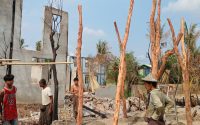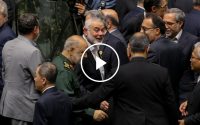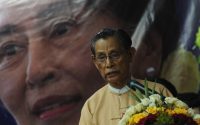Modi’s Power Keeps Growing, and India Looks Sure to Give Him More
As he campaigns across India for an election that begins on Friday, Prime Minister Narendra Modi speaks of his insatiable ambitions in terms of dinner-table appetite.
Roofs over heads, water connections, cooking gas cylinders — Mr. Modi reads down the menu of what he calls the abundant “development” he has provided to India’s poor. But he’s not stopping there. “What Modi has done so far is just the appetizer,” he said at one stop, referring to himself in the third person, as he often does. “The main course is yet to come.”
To Mr. Modi’s legions of supporters, a third term would bring more of what they find so appealing in him. He is that rare breed of strongman who keeps an ear to the ground. He is a magnetic figure and a powerful orator. He has built an image as a tireless, incorruptible worker for a country on the rise.
But to his critics, Mr. Modi’s talk of a “main course” is an alarm bell for the future of the world’s largest democracy.
Mr. Modi, 73, enters the election a heavy favorite, his party’s grip over India’s more populous northern and central heartlands firmer than ever, the opposition in the same decisive geography even more diminished. Yet even with his place as India’s unrivaled leader seemingly secured, he has carried out a crackdown on dissent that has only intensified.
In the lead-up to the voting, which will run for six weeks before results are announced on June 4, agencies under Mr. Modi’s control have frozen the bank accounts of the largest opposition party. The leaders of two opposition-run states have been thrown in jail, in cases they call politically motivated. (The capital region, New Delhi, is currently governed by a chief minister who sends his directives from behind bars.)
All of this, Mr. Modi’s critics say, shows the penchant for full control that has become evident over his decade as prime minister. Mr. Modi, they contend, will not stop until he has turned India’s democracy into one-party rule. Power is being aggressively consolidated “around the cult of the leader’s personality,” said Yamini Aiyar, a policy analyst in New Delhi.
“The deep centralization of power has significantly undermined institutional checks and balances baked into India’s democratic structure,” Ms. Aiyar said.
Many Indians seem willing to accept this. Mr. Modi has remained deeply popular even as he has become more autocratic. He has paid little price — and even found support — for his effort to remake India into what analysts have called an illiberal democracy.
He exploits contradictions. The right to vote is held as sacred in a country whose democracy has offered protection in a turbulent region. But polling also indicates that large numbers of Indians are willing to cede civil liberties to support a powerful ruler they see as getting things done.
Another seeming incongruity: People who speak of their own economic strife also often express faith in Mr. Modi’s running of the country’s affairs, a testament to the forceful narratives he weaves.
Indians have more tangible reasons to back him, too. Mr. Modi relentlessly tends his broad support base through generous offerings across society: favorable deals for the business elite in a growing economy, robust welfare programs for India’s impoverished majority, and a strong dose of Hindu nationalism for those in between.
A campaign stop this month in his party’s stronghold of Uttar Pradesh illustrated this winning formula.
Mr. Modi stood in the back of a saffron-colored truck as it moved slowly down a shopping street lined with global brands and jewelry shops, a scene that spoke to the new wealth that has lifted millions of Indians into the middle class.
Overhead, billboards with pictures of Mr. Modi — his face is everywhere in India — told of achievements like the installation of more than 100 million toilets for the poor and India’s rising stature.
At the end of the “roadshow,” at the junction where Mr. Modi’s vehicle turned right and headed back to Delhi, was a stage set up with loudspeakers. As Hindu nationalist songs blared, actors dressed up as the deities Ram and Sita posed for selfies with the crowd.
Mr. Modi’s inauguration in January of a huge temple dedicated to Ram, on the disputed site of a mosque razed three decades ago by a Hindu mob, has been a major election-year offering to his Hindu base.
“We are Hindu, we are Hindu, we will only speak of Ram,” went one song’s chant. “Those who brought Ram, we will bring them to power.”
Mr. Modi’s Bharatiya Janata Party, or B.J.P., started in 1980 as an urban middle-class organization centered around a Hindu majoritarian core. Under Mr. Modi, it has recast itself as the party of the poor and of the village in northern India, analysts say.
Some in India believe that poorer people have merely fallen under Mr. Modi’s spell. Nalin Mehta, the author of the book “The New B.J.P.,” called that fundamentally wrong.
“The fact that the B.J.P. continues to win these victories reflects how successful it has been in getting newer constituents of voters who never voted B.J.P. before, and who may not even be followers of Hindu nationalism,” he said.
Mr. Mehta attributes much of that success to the party’s expansion and branding of welfare programs and its efforts to promote itself as pan-Hindu, actively reaching out to India’s marginalized castes.
By prioritizing direct digital welfare payments, the B.J.P. has cut out the middleman and made sure the handouts are seen as coming straight from Mr. Modi.
Technology also allows the party to follow up, with B.J.P. workers — armed with data — knocking on the door of anyone who received a water tap, a gas cylinder or a government grant to build a home.
Data creates layers of feedback that help the party pick its candidates, jettisoning large numbers of incumbents before each election. “This B.J.P. is very ruthless on winnability,” Mr. Mehta said.
Bringing it all together are Mr. Modi’s outsize appeal and his political and technological acumen.
He has put his personal story at the center of his narrative of an ascendant India, the main pillar of his campaign. If a lower-caste son of a chai seller can become one of the most powerful men in the world, he says, other ordinary Indians can dream, too.
While inequality has grown and 800 million Indians are at the mercy of monthly rations, many focus instead on their faith that Mr. Modi is not a thief. He casts himself as a bachelor with no descendants who works only for the Indian people, unlike what he calls the corrupt political dynasts in the opposition.
“Modi wasn’t born in some royal family to become prime minister,” he told a crowd of tens of thousands in the state of Maharashtra. “It’s you who have brought him this far.”
The political opposition has been severely weakened by infighting, leadership crises and its struggle to offer an ideological alternative to the B.J.P.
But it also faces a playing field that Mr. Modi has tilted in his own favor.
He has cowed the broadcast media. Independent journalists who do question his policies have been jailed or subjected to legal harassment. India leads the world in internet shutdowns, obscuring unrest that looks bad for the government. And officials under Mr. Modi have forced social media platforms to scrape critical content.
Investigating agencies have been set loose on Mr. Modi’s political opponents — more than 90 percent of cases involving politicians over the past decade have involved the opposition. Many languish in jail or the court system. Those who switch allegiance to the B.J.P. find that their cases vanish.
On the campaign trail in the state of West Bengal, an opposition candidate, Mahua Moitra, spoke of saving democracy from the authoritarianism she said had led to her own expulsion from Parliament — in a messy case involving a former romantic partner, a Rottweiler named Henry and accusations of graft.
Autocracy and Mr. Modi’s perceived coziness with billionaires have been the opposition’s two main attack lines. While campaigning, Ms. Moitra told a group of women that they were still waiting for government money to build homes because Mr. Modi “is busy building palaces for his friends.”
Analysts doubt that either issue will resonate widely. Many Indians, particularly in his stronghold in the north, which has a decisive say in who rules from New Delhi, like exactly what they are getting from Mr. Modi.
“He is the prime minister, and if he is not strong enough, then what good would it be?” Anjali Vishwakarma, 37, an interior designer, said as she walked along the Ganges one recent day with her family in Mr. Modi’s constituency of Varanasi.
Suhasini Raj contributed reporting from Varanasi, Sameer Yasir from Krishnanagar and Hari Kumar from Ghaziabad in India.


